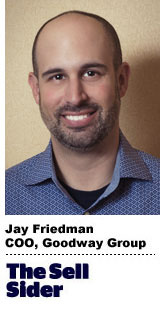 “The Sell Sider” is a column written by the sell side of the digital media community.
“The Sell Sider” is a column written by the sell side of the digital media community.
Today’s column is written by Jay Friedman, COO at Goodway Group.
In the past two weeks, I’ve been to two supply-side platform (SSP) summits and spoken in depth to more than a dozen publishers. I’ve learned a lot.
In short, the open exchanges are experiencing a renaissance due to efforts such as Ads.txt, and private marketplaces (PMPs) are programmatic advertising’s biggest time suck.
I truly believe the industry spends as much in time and labor fixing PMPs as it does spending in PMPs. One SSP recently launched a PMP diagnosis tool. Think about the amount of engineering that went into just creating the tool, not to mention the amount of problems that must have caused the need for such a tool.
It’s not just SSPs that are spending time diagnosing the problems. It’s buyers, agencies, demand-side platforms (DSPs) and publishers. PMPs are truly the gift that keeps on taking.
Pay up. But for what?
My personal experience is that PMPs run at least twice the cost of inventory from the same publisher in the open exchange, and I’ve heard the differential is as high as 4.6 times. But are buyers getting that much incremental value? I don’t believe so.
Most often the inventory in PMPs is the same as what is available in the open exchange. Publishers largely tell me that buyers are not using PMPs to secure inventory otherwise unavailable in the open exchange. Plus, the 2x to 4.6x in hard costs doesn’t include the time costs, making the overall price tag much higher.
So, perhaps PMPs are used to ensure inventory quality and avoid fraud? If so, there are plenty of ways to secure high-quality traffic in the open exchange.
The safety of the open exchange is New York City post-2000
In 1990 New York City had 2,605 murders – the worst in recorded history. Since then, it’s fallen drastically, with the year 2000 being the first year below 1,000.
That doesn’t mean that in 2000 people thought NYC was safe. There were still lingering perceptions. But many major problems had largely been cleaned up and it was safe to walk around most neighborhoods.
The open exchange is experiencing a similar phenomenon. Just a couple of years ago a buyer had to be tremendously sophisticated to avoid large amounts of fraud in the open exchange. This drove marketers and agencies to PMPs.
But between Ads.txt adoption and the largest DSPs using true invalid traffic-prevention solutions, the open exchange is largely safe for those who know how to buy programmatic intelligently – and know the right “neighborhoods.”
In defense of PMPs
It’s not that PMPs should never be a part of a digital media strategy, but they must be considered more rationally. There may be inventory that truly isn’t available in the open exchange. Buying second-party audiences – when there is value in them – is another great reason to use a PMP.
Also, video, especially connected TV, is still a smart place to execute PMPs. Many publishers sell 100% of their video directly, meaning there is less available in the open exchange in the first place. And with video CPMs 10 times higher or more than display, video is a highly desirable fraud target.
About that $10 video CPM you’re buying – I’ve got a $50 Gucci handbag to sell you, too.
Follow Jay Friedman (@jaymfriedman) and AdExchanger (@adexchanger) on Twitter.
This post was syndicated from Ad Exchanger.

More Stories
Buyers Are Wasting Money on Alt IDs While Cookies Still Persist
Ibotta Crosses The IPO Finish Line – Now The Real Work Begins
Commerce Can No Longer Be Where Creative Goes to Die